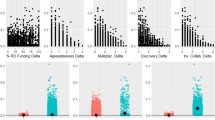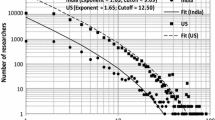Abstract
This paper investigates the role of homophily and focus constraint in shaping collaborative scientific research. First, homophily structures collaboration when scientists adhere to a norm of exclusivity in selecting similar partners at a higher rate than dissimilar ones. Two dimensions on which similarity between scientists can be assessed are their research specialties and status positions. Second, focus constraint shapes collaboration when connections among scientists depend on opportunities for social contact. Constraint comes in two forms, depending on whether it originates in institutional or geographic space. Institutional constraint refers to the tendency of scientists to select collaborators within rather than across institutional boundaries. Geographic constraint is the principle that, when collaborations span different institutions, they are more likely to involve scientists that are geographically co-located than dispersed. To study homophily and focus constraint, the paper will argue in favour of an idea of collaboration that moves beyond formal co-authorship to include also other forms of informal intellectual exchange that do not translate into the publication of joint work. A community-detection algorithm for formalising this perspective will be proposed and applied to the co-authorship network of the scientists that submitted to the 2001 Research Assessment Exercise in Business and Management in the UK. While results only partially support research-based homophily, they indicate that scientists use status positions for discriminating between potential partners by selecting collaborators from institutions with a rating similar to their own. Strong support is provided in favour of institutional and geographic constraints. Scientists tend to forge intra-institutional collaborations; yet, when they seek collaborators outside their own institutions, they tend to select those who are in geographic proximity. The implications of this analysis for tie creation in joint scientific endeavours are discussed.


Similar content being viewed by others
Notes
The next largest component has fewer than 100 authors.
Descriptions of these divisions and groups are available at the website of the Academy of Management: http://www.aomonline.org/aom.asp.
Here \({\mathcal{P}}\) is a partition of the vertices of our graph. That is, \({\mathcal{P}}\) is a set of communities \({\mathcal{C}}\) and every author in the largest connected component of our full weighted co-authorship graph is in one but only one of these communities.
The java code used to perform the optimisation of Q(γ) is available on request from T. S. Evans.
References
Allen, T. (1977). Managing the flow of technology. Cambridge, MA: MIT Press.
Baker, M. J., & Gabbott, M. (2002). The assessment of research. International Journal of Management Education, 2(3), 3–15.
Ball, D. F., & Butler, J. (2004). The implicit use of business concepts in the UK research assessment exercise. R & D Management, 34(1), 87–97.
Barabási, A. L., Jeong, H., Neda, Z., Ravasz, E., Schubert, A., & Vicsek, T. (2002). Evolution of the social network of scientific collaborations. Physica, 311, 590–614.
Blondel, V. D., Guillaume, J.-L., Lambiotte, R., & Lefebvre, E. (2008). Fast unfolding of communities in large networks, Journal of Statistical Mechanics, P10008.
Börner, K., Chen, C. M., & Boyack, K. W. (2003). Visualizing knowledge domains. Annual Review of Information Science and Technology, 37, 179–255.
Boyack, K. W., Klavans, R., & Börner, K. (2005). Mapping the backbone of science. Scientometrics, 64, 351–374.
Braunerhjelm, P., & Feldman, M. (2006). Cluster genesis: Technology-based industrial development. Oxford: Oxford University Press.
Cairncross, F. (1997). The death of distance. Cambridge MA: Harvard University Press.
Camic, C. (1992). Reputation and predecessor selection: Parsons and the institutionalists. American Sociological Review, 57, 421–445.
Chen, C. M. (2003). Mapping scientific frontiers: The quest for knowledge visualization. Berlin: Springer.
Chung, S., Singh, H., & Lee, K. (2000). Complementarity, status similarity and social capital as drivers of alliance formation. Strategic Management Journal, 21, 1–22.
Colizza, V., Flammini, A., Serrano, M. A., & Vespignani, A. (2006). Detecting rich-club ordering in complex networks. Nature Physics, 2, 110–115.
Cooper, C., & Otley, D. (1998). The 1996 research assessment exercise for business and management. British Journal of Management, 9, 73–89.
Crane, D. (1972). Invisible colleges. Chicago: University of Chicago Press.
Cummings, J. N., & Kiesler, S. (2007). Coordination costs and project outcomes in multi-university collaborations. Research Policy, 36(10), 138–152.
De Castro, R., & Grossman, J. W. (1999). Famous trails to Paul Erdös. Mathematical Intelligence, 21, 51–63.
Ding, Y., Foo, S., & Chowdhury, G. (1999). A bibliometric analysis of collaboration in the field of information retrieval. International Information and Library Review, 30, 367–376.
Expert, P., Evans, T. S., Blondel, V. D., & Lambiotte, R. (2011). Uncovering space-independent communities in spatial networks. Proceedings of the National Academy of Science, 108, 7663–7668.
Feld, S. L. (1981). The focused organization of social ties. American Journal of Sociology, 86, 1015–1035.
Fortunato, S. (2010). Community detection in graphs. Physics Reports, 486, 75–174.
Frenken, K., Hardeman, S., & Hoekman, J. (2009). Spatial scientometrics: Towards a cumulative research program. Journal of Informetrics, 3, 222–232.
Gertler, M. S. (2003). Tacit knowledge and the economic geography of context or the undefinable tacitness of being (there). Journal of Economic Geography, 3, 75–99.
Greenfeld, L. (1989). Different worlds: A sociological study of taste, choice and success in art. Cambridge, England: Cambridge University Press.
Hellsten, I., Lambiotte, R., Scharnhorst, A., & Ausloos, M. (2007). Self-citations, co-authorships and keywords: A new method for detecting scientists’ field mobility? Scientometrics, 72, 469–486.
Higher Education & Research Opportunities (HERO) in the United Kingdom (2001). A Guide to the 2001 Research Assessment Exercise.
Hidalgo, C. A., Klinger, B., Barabási, A. L., & Hausmann, R. (2007). The product space conditions the development of nations. Science, 317, 482–487.
Jaffe, A. B., Trajtenberg, M., & Henderson R. (1993). Geographic localization of knowledge spillovers as evidenced by patent citations. Quarterly Journal of Economics, 108(3), 578–598.
Jones, B. F., Wuchty, S., & Uzzi, B. (2008). Multi-university research teams: Shifting impact, geography, and stratification in science. Science, 322(5905), 1259–1262.
Katz, J. S., & Martin, B. R. (1997). What is research collaboration?. Research Policy, 26, 1–18.
Kossinets, G., & Watts, D. J. (2006). Empirical analysis of an evolving social network. Science, 311, 88–90.
Kraut, R., Egido, C., & Galegher, J. (1990). Patterns of contact and communication in scientific research collaboration. In J. Galegher, R. Kraut, & C. Egido (Eds.) Intellectual teamwork: Social and technological bases of cooperative work (pp. 149–171). Hillsdale, NJ: Lawrence Erlbaum.
Laband, D. N., & Tollison, R. D. (2000). Intellectual collaboration. Journal of Political Economy, 108, 632–662.
Lambiotte, R., & Panzarasa, P. (2009). Communities, knowledge creation and information diffusion. Journal of Informetrics, 3, 180190.
Latour, B. (1987). Science in action. Cambridge, MA: Harvard University Press.
Lazarsfeld, P. F., & Merton, R. K. (1954). Friendship as social process: A substantive and methodological analysis. In M. Berger, T. Abel & C. Page (Eds.) Freedom and control in modern society (pp. 18–66). New York, NY: Van Nostrand.
Leydesdorff, L., & Ward, J. (2005). Science shops: Adoscope of science-society collaborations in Europe. Public Understanding of Science, 14, 353–372.
Leydesdorff, L., & Rafols, I. (2008). A global map of science based on the ISI subject categories. Journal of the American Society for Information Science, 60, 348–362.
Lorange, P., & Roos, J. (1992). Strategic alliances. Cambridge, MA: Blackwell.
McPherson, J. M., Smith-Lovin, L., & Cook, J. M. (2001). Birds of a feather: Homophily in social networks. Annual Review of Sociology, 27, 415–444.
Monge, P., Rothman, L., Eisenberg, E., Miller, K., & Kirste, K. (1985). The dynamics of organizational proximity. Management Science, 31, 1129–1141.
Moody, J. (2004). The structure of social science collaboration network: Disciplinary cohesion from 1963 to 1999. American Sociological Review, 69, 213–238.
Newman, M. E. J. (2001a). The structure of scientific collaboration networks. Proceedings of the National Academy of Science, 98, 404–409.
Newman, M. E. J. (2001b). Scientific collaboration networks. I. Network construction and fundamental results. Physical Review E, 64, 016131.
Newman, M. E. J., & Girvan, M. (2004). Finding and evaluating community structure in networks. Physical Review E, 69, 026113.
Opsahl, T., Colizza, V., Panzarasa, P., & Ramasco, J. J. (2008). Prominence and control: The weighted rich-club effect. Physical Review Letters, 101, 168702.
Podolny, J. M. (1994). Market uncertainty and the social character of economic exchange. Administrative Science Quarterly, 39, 458–483.
Podolny, J. M., & Stuart, T. E. (1995). A role-based ecology of technological change. American Journal of Sociology, 100, 1224–1260.
Price, D. J. de S. (1965). Networks of scientific papers. Science, 149, 510–515.
Reagans, R. (2005). Preferences, identity, and competition: Predicting tie strength from demographic data. Management Science, 51(9), 1374–1383.
Reichardt, J., & Bornholdt, S. (2004). Detecting fuzzy community structures in complex networks with a Potts model. Physical Review Letters, 93, 218701.
Rosvall, M., & Bergstrom, C. T. (2008). Maps of random walks on complex networks reveal community structure. Proceedings of the Natonal Academy of Science, 105, 1118.
Scharnhorst, A., & Ebeling, W. (2005). Evolutionary search agents in complex landscapes—A new model for the role of competence and meta-competence (EVOLINO and other simulation tools), arXiv:0511232.
Traud, A. L., Kelsic, E. D., Mucha, P. J., & Porter, M. A. (2010) Community structure in online collegiate social networks, arXiv:0809.0690.
Wallace, M. L., & Gingras, Y. (2008). A new approach for detecting scientific specialties from raw cocitation networks. Journal of the American Society for Information Science, 60, 240–246.
Whitfield, J. (2008). Group theory. Nature, 455, 720–723.
Wuchty, S., Jones, B. F., & Uzzi, B. (2007). The increasing dominance of teams in production of knowledge. Science, 316, 1036–1039.
Author information
Authors and Affiliations
Corresponding author
Rights and permissions
About this article
Cite this article
Evans, T.S., Lambiotte, R. & Panzarasa, P. Community structure and patterns of scientific collaboration in Business and Management. Scientometrics 89, 381–396 (2011). https://doi.org/10.1007/s11192-011-0439-1
Received:
Published:
Issue Date:
DOI: https://doi.org/10.1007/s11192-011-0439-1




